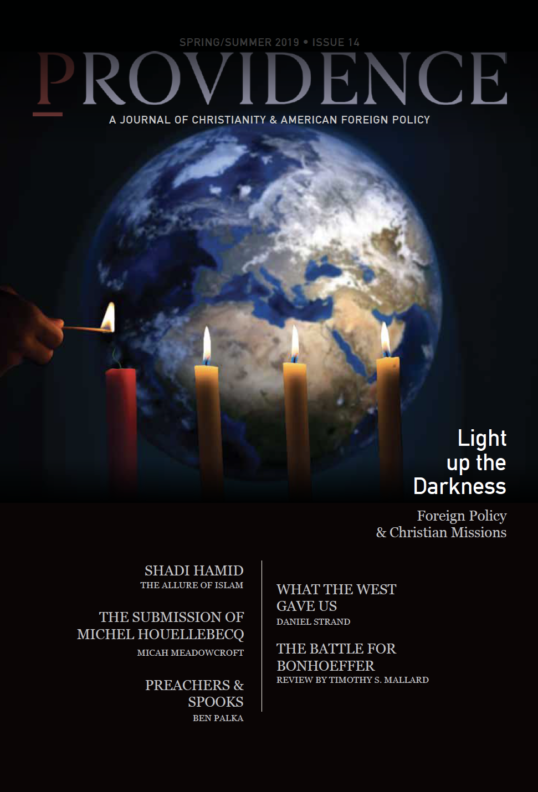The American-led Protestant missions in Korea achieved perhaps the most rapid and complete transformation of a nation in the history of Christianity, but they disappeared into almost complete obscurity by the time that the Korean War forced Americans to pay attention to Korea. Few religious, social, or political movements have risen as quickly or enduringly, or been aligned as well with US foreign policy without receiving any recognition from Americans. The current time of change in the Korean peninsula is an appropriate opportunity to revisit and remember this unique episode that was the genesis of the US-Korea relationship of today.
Korean Christianity: An American-Inspired Revolutionary Movement
American missionaries brought Christianity to Korea at a time when the country’s centuries-old kingdom and social order were dying, and patriots from the king to the common people were searching for a new way of life. Before and during the early 1880s, Korea experienced foreign military incursions that exposed its vulnerability to modern armies and navies of the late nineteenth century, and the kingdom signed an unequal treaty with Japan in 1876. The last king of Korea, Gojong, saw the United States as Korea’s only possible ally and opened its first formal diplomatic relations with the United States in 1882. He welcomed American missionaries as carriers of ideas that would bring Korea into the modern world. There had been Catholic and Protestant missionaries from Europe before, and thousands of Korean converts were martyred because professing Christianity was a capital offense. But in 1884, an American medical doctor named Horace Allen became the first to receive royal permission to proselytize. American Presbyterians and Methodists transformed the country’s culture in the decades that followed.
American Christians began the transformation of a mostly illiterate and uneducated people—whose upper class emulated Chinese culture and learned its language—into a nation fiercely proud of its distinct language and alphabet; by the twenty-first century Korea was known worldwide for its high level of education. Homer Hulbert, an educational missionary, arrived in Korea in 1886 to teach at the Royal English School in Seoul—Korea’s first Western-style government-sponsored school. He created Korea’s first public schools and textbooks and began mass instruction in today’s official Hangul script, the Korean alphabet created in the 1400s that had long since fallen into disuse because of the educated class’ use of Mandarin Chinese. Korea’s first college, Union Christian College in Pyongyang, opened in 1905, and in 1915 a Presbyterian missionary named Horace Grant Underwood founded Chosun Christian College in Seoul, which still exists today as Yonsei University, one of Korea’s leading universities. American missionary leadership of higher education in Korea continued under Japanese rule until 1941, when Japan interned and deported the last American missionaries after its attack on Pearl Harbor.
Presbyterian and Methodist churches created under American guidance, not the Catholic Church brought by European clergy, led the explosive growth of Korean Christianity in the late nineteenth and early twentieth centuries. In 1900, there were 60,000 Christians in Korea (21,000 of them Protestants) and by 1910 there were over 200,000 Christians, two-thirds of them Protestants. The Korean Presbyterian and Methodist churches have continued to predominate in Korea into the twenty-first century.
The Presbyterian and Methodist churches in Korea flourished in part because from the beginning their American founders planned for their converts to take over the churches and encouraged them to take their new religion in their own direction. A Presbyterian seminary for Koreans opened in Pyongyang in 1905 and graduated its first class in 1907. In the same year there began a surge of conversions called the Great Pyongyang Revival, in which Korean Christians in Pyongyang spontaneously confessed their failures and those of their nation then spread throughout the country to share the word and make new converts. The early Korean Christians showed this zeal and independence even further when the Presbyterians decided to send their own mission to China in 1912. Only five years after their first clergymen had been ordained, they already were prepared to go forth and preach to the Chinese, whose culture they had once emulated.
American political ideas and Christianity became inseparable elements of the Korean independence movement long before 1945 as Korean Christians became leaders of the patriot movements resisting Japan’s invasions and occupation of Korea that started in 1905. American missionaries avoided overt support for Korean nationalists, certain the Japanese would jail or expel them for it, but the schools and churches they founded became magnets for Korean patriots and refugees who gathered and organized there without fear of arrest by Japanese authorities.
The March First Movement of 1919 showed the influence of the American missions on Korea’s independence movement. The March First Movement was a nonviolent revolution that Koreans in both the North and South consider to be the start of the Korean independence struggle. South Korea has made March 1 its Independence Day, and the shadowy North Korean resistance group called Cheollima Civil Defense issued its declaration of revolution against the regime of Kim Jong-un on March 1, 2019. The leaders of the March First Movement included 33 men and women, 16 of them Christians at a time when less than two percent of the population were; they met in Seoul in Seung Dong Presbyterian Church (which still exists today) to sign a Declaration of Independence. They demanded the end of colonial rule by Japan and called for the United States under President Woodrow Wilson, who had issued the Fourteen Points in January 1918, and other foreign powers to support Korean self-determination. Over 1,500 demonstrations roiled Korea in March and April 1919, but American missionaries informing American and international news media was their only foreign support. Japanese troops crushed the movement, with Korean sources claiming 7,500 Koreans killed, 15,000 wounded, and 46,000 arrested.
A Korean government in exile, which the Republic of Korea considers its predecessor just as the US government considers the Continental Congress, began under mainly Christian leaders during the March First Movement. The Korean Provisional Government founded in April 1919 spent a quarter century struggling for Korean independence in exile in Shanghai and elsewhere in the Republic of China. Its first president was Syngman Rhee, a Presbyterian educated in an American school in Seoul and then in the United States at George Washington, Princeton, and Harvard. His successor from 1927 to 1945 was Kim Ku, a convert who had learned about Christianity and Western ideas while in prison for killing a Japanese man. He embraced both Christianity and these Western ideas after escaping and living for years in rural Korea as a fugitive from the Japanese authorities. Kim Ku led the Korean Provisional Government in a triumphal return to Korea after US forces liberated the country in 1945.
Disappearance into the Greatest Generation
The American missions in Korea flourished until rising Japanese repression and war between the United States and Japan ended their presence. In the late 1930s, the Presbyterians withdrew from the schools they had founded when Japanese authorities compelled their students to worship the emperor of Japan, which they held to be a violation of the second commandment. Most Americans evacuated Korea in 1940 when the US Department of State warned them that war with Japan was imminent; the remainder were interned by Japan after the attack on Pearl Harbor in December 1941 and repatriated to the United States in 1942 in an exchange of citizens by the United States and Japan.
The grandchildren of the founders of the American missions in the 1880s and the sons of the leaders of the early twentieth century were military age during the 1940s and became parts of the vast US war effort of the Second World War. Most joined the armed forces and became soldiers, sailors, airmen, and Marines, but some joined the new US intelligence service, the Office of Strategic Services (OSS). OSS Director William Donovan had taken a special interest in Korea as a potential fifth column in the Japanese Empire since the first days after Pearl Harbor, and the OSS recruited numerous sons of missionaries to lead its projects to recruit Koreans and to infiltrate them into Korea as intelligence operators. They included Project NAPKO, which trained Korean agents on Catalina Island, California, and planned to insert them into Korea from the Pacific by midget submersible; and Project Eagle, based in Xian, China, which cooperated with the Korean Provisional Government and trained exiled soldiers of its army to infiltrate Korea by parachute or overland from China.
After the war some of these sons of both America and Korea returned to Korea with the US armed forces to contribute their knowledge of the country to the US military government of liberated Korea. They became the only American experts on Korea in the US occupation force, contributing immeasurably to its actions but exerting no influence over the decisions of the distant Department of State in Washington. US strategic mistakes abounded in Korea as a result as the Department of State refused to allow the US military government to support the Korean Provisional Government; the Korean Provisional Government dissolved into factions around Kim Ku, Syngman Rhee, and other leaders. Syngman Rhee won a bloody contest for power, all while the Soviet Union systematically created a Communist regime under Kim Il-sung in the north.
Forgotten But Not Gone
Americans were destined to poorly understand the Republic of Korea, established in the south in 1948. The American public never knew, and the US government never sponsored or recognized, the role of turn-of-the-century American missionaries in Korea, which traced its intellectual heritage to those Christians. Korea became a thriving democracy with a predominantly Christian society, and Christians outnumbered all other faiths by the end of the twentieth century; embracing Christianity became practically obligatory in the educated class. Meanwhile, few Americans know that American missionaries brought these ideas to Korea in the late nineteenth and early twentieth centuries. The American missionaries of Korea were forgotten in the United States, or never actually known in the first place.
The academic profession in the United States has completed the forgetting of the American past in Korea. The study of Korea in US universities was hijacked by leftist academics such as Bruce Cumings, who has ruthlessly denied the significance of Korean Christianity and the democratic aspirations of Korean nationalists that date back over a century. Events such as the March First Movement and the spread of Christianity do not exist in Cumings’ version of Korea’s history, which is not unlike a history of Israel written by a Holocaust denier.
Koreans themselves are amply aware of the American past in Korea and the role of missionaries in it. The Korean Presbyterian and Methodist churches and the universities that trace their origins back to American missionaries have never forgotten, and organizations, such as the Homer Hulbert Memorial Society, are rediscovering the contributions of Americans to the survival and modernization of Korea. Americans would be well advised to re-learn the role of American missionaries in the history of Korea and the relevance of that past to the ongoing US disputes with North Korea and the evolving US-South Korea relationship.







 Live in the DC area? Sign-up for Providence's in-person events list!
Live in the DC area? Sign-up for Providence's in-person events list!